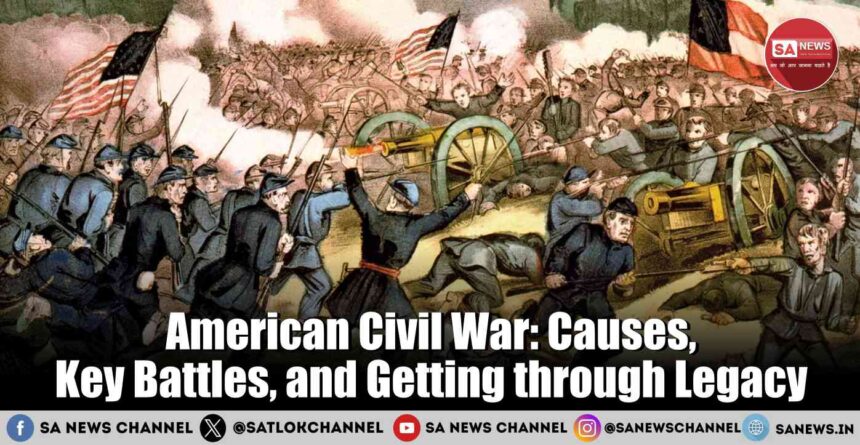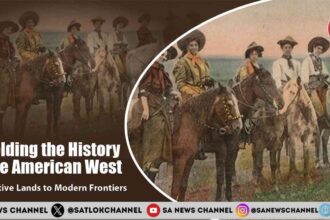The American Civil War stays as one of the most critical events in U.S. history. Struggled some place in the scope of 1861 and 1865, the contention was on a very basic level between the Northern states (Affiliation) and the Southern states (Coalition), which had been removed from the Affiliation. The conflict was laid out in deeply grounded issues like coercion, states’ opportunities, and financial contrasts. The contention achieved huge changes to the political, social, and monetary scene of the US.
- American Civil War Key Points
- Purposes behind the American Civil War
- Coercion and Money related Differentiations
- States’ Honors versus Government Authority
- American Civil War: Social and Social Differences
- The Start of the Civil War
- The Arrangement of Abraham Lincoln
- Severance of Southern States
- Plan of the Confederate Domains of America
- Key Battles and Military Missions
- Extremely important occasions of the Contention
- The Completion of the Cross country struggle
- American Civil War: The Repercussions and Redoing
- Spirituality Can Reduce Gap and Make Society Tolerant
- FAQs about American Civil War
- What were the essential drivers of the American Cross country struggle?
- How did the American Civil War impact slavery?
- What were the fundamental clashes of the Civil War?
- When did the Civil War end??
- What was the Entertainment time?
- Connect With Us on the Following Social Media Platforms
American Civil War Key Points
- The American Civil War was fought from 1861 to 1865 between the Affiliation (North) and the Union (South).
- Key causes included bondage, states’ honors, and monetary differentiations between the North and South.
- Critical battles like Gettysburg and Sherman’s Stroll to the Sea described the dispute.
- The contention wrapped up with the Partnership’s quiet submission and incited the revocation of coercion.
- Redoing and social correspondence improvements shaped the post-war time, affecting present day American culture.
Purposes behind the American Civil War
Coercion and Money related Differentiations
American Civil War: Coercion was the central issue that separated the North and South. The Northern states had by and large invalidated servitude and were industrializing, while the Southern economy relied strongly upon mistreated work for its agricultural endeavors, particularly cotton. These financial differentiations made significant strains about whether new locales and states would allow coercion.
States’ Honors versus Government Authority
The South fought for states’ rights to govern themselves, including the choice to allow slavery. In contrast, the North supported a strong central government to enforce national laws, especially regarding slavery.
Also Read: Exploring Ancient Greece: From Early Civilizations to Roman Rule
American Civil War: Social and Social Differences
The North and South made specific social orders, with the South embracing a more regular, agrarian lifestyle, while the North ended up being more metropolitan and present day. These social qualifications filled the philosophical split between the two districts.
The Start of the Civil War
The Arrangement of Abraham Lincoln
American Civil War: Abraham Lincoln’s political choice in 1860 was the tipping point for Southern severance. Lincoln was against the improvement of enslavement, and his victory convinced a couple of Southern states to feel that their way of life was under risk.
Severance of Southern States
Following Lincoln’s political choice, 11 Southern states pulled out from the Affiliation and molded the Confederate Domains of America. This showing of severance was one of the huge purposes behind the Cross country struggle, as the North didn’t see the legitimateness of the Coalition.
Plan of the Confederate Domains of America
Driven by Jefferson Davis, the Partnership was molded in mid 1861, and in a little while, Confederate powers pursued Fortification Sumter, legitimately starting the Cross country struggle.
Key Battles and Military Missions
American Civil War: Conflict of Post Sumter
The primary shots of the Cross country struggle were released at Post Sumter in April 1861, signifying the beginning of a crazy four-year battle. Though the genuine battle was minor, its delegate significance was huge.
Engagement of Gettysburg
American Civil War: Fought in July 1863, the Conflict of Gettysburg was one of the fundamental encounters of the Cross country struggle. It was a vital turning point that halted the Confederate interruption of the North and set up for the Affiliation’s conceivable victory.
Extremely important occasions of the Contention
Gettysburg and Vicksburg
The twin victories at Gettysburg and Vicksburg in 1863 meant a vital crossroads in the contention. These battles out and out crippled the Confederate powers and lifted Northern sensation of certainty.
The Arrangement of 1864
Lincoln’s re-arrangement in 1864 ensured that the Affiliation would continue with its fight until the Collusion was squashed. His power expected a central part in shielding the country.
The Completion of the Cross country struggle
Surrender at Appomattox Municipal center
American Civil War: On April 9, 1865, General Robert E. Lee surrendered to General Ulysses S. Grant at Appomattox Municipal center, effectively completing the Cross country struggle. The passive consent meant the breakdown of the Partnership and the reunification of the US.
Demise of Abraham Lincoln
Just a short time after the contention got done, President Lincoln was killed by John Wilkes. This destruction staggered the nation and made a long-lasting engraving on the post-war period.
American Civil War: The Repercussions and Redoing
Patching up the South
The Multiplication time frame focused in on adjusting the South’s economy and society. In any case, the connection was loaded with troubles, including political battles and all over racial strains.
The Freedmen’s Organization
Spread out in 1865, the Freedmen’s Organization helped as of late freed African Americans with advancing to a valuable open door by giving preparation, business, and genuine assistance.
Changes to the Constitution
The thirteenth, fourteenth, and fifteenth Changes, passed after the Cross country struggle, were expected to end bondage and give identical opportunities to African Americans, but their full execution would require much more numerous years.
Spirituality Can Reduce Gap and Make Society Tolerant
The American Civil War shows how deep divisions can tear a society apart, but also highlights the power of unity and rebuilding stronger. Conflicts happen in life, but resolution and healing lead to progress. Spirituality brings peace and patience to society. Today, Saint Rampal Ji Maharaj is working to bridge these gaps, and following His path of spirituality and social reform can benefit everyone.
FAQs about American Civil War
What were the essential drivers of the American Cross country struggle?
The essential drivers were subjugation, states’ opportunities, financial differences, and the social split between the North and South.
How did the American Civil War impact slavery?
The contention incited the cancelation of servitude through the Freedom Announcement and the thirteenth Amendment to the U.S. Constitution.
What were the fundamental clashes of the Civil War?
The Engagement of Gettysburg, the Conflict of Post Sumter, and Sherman’s Stroll to the Sea were among the most huge.
When did the Civil War end??
The contention completed on April 9, 1865, with the Confederate quiet submission at Appomattox Municipal center.
What was the Entertainment time?
The Redoing time frame followed the Cross country struggle, focusing in on patching up the South and organizing as of late freed African Americans into society.









